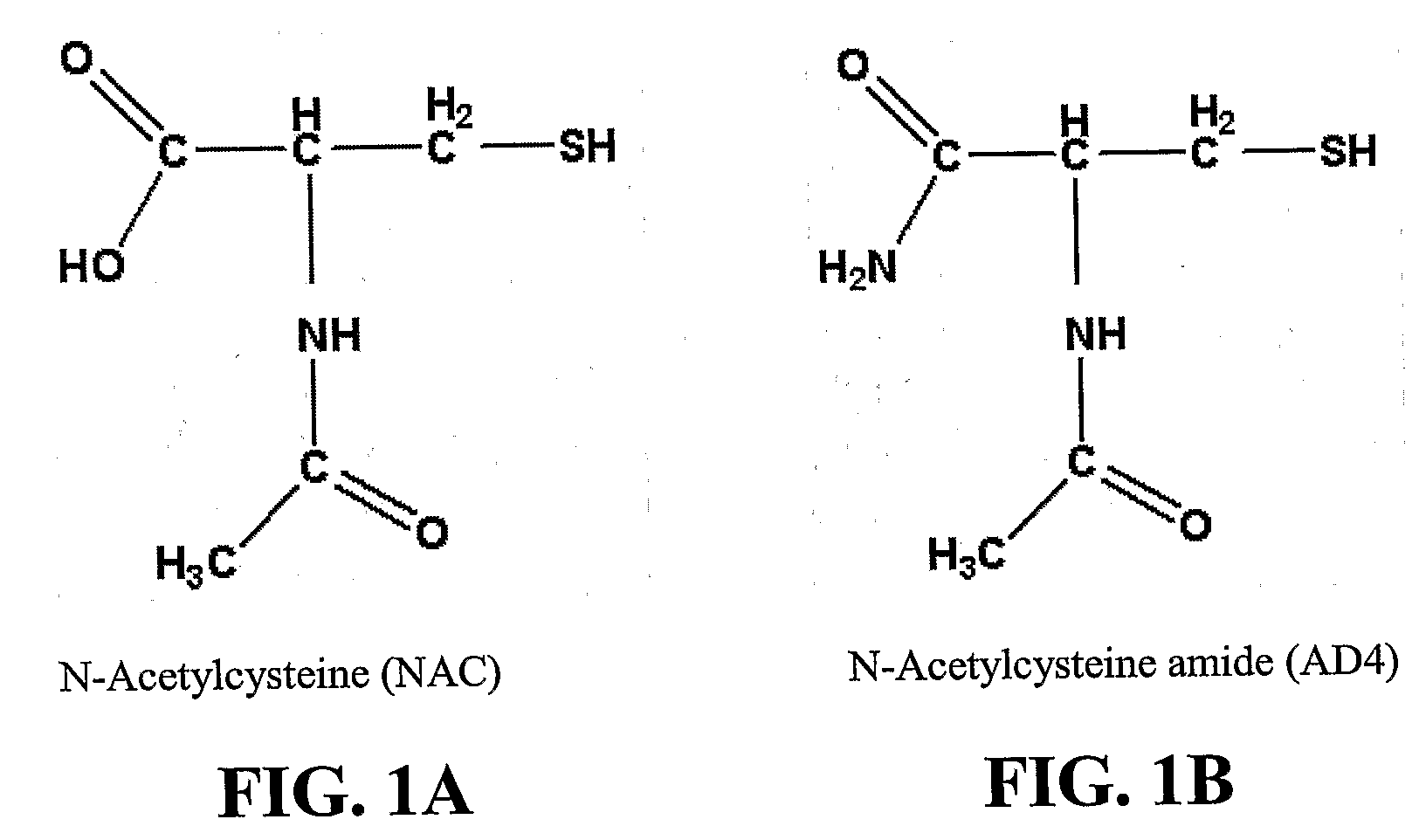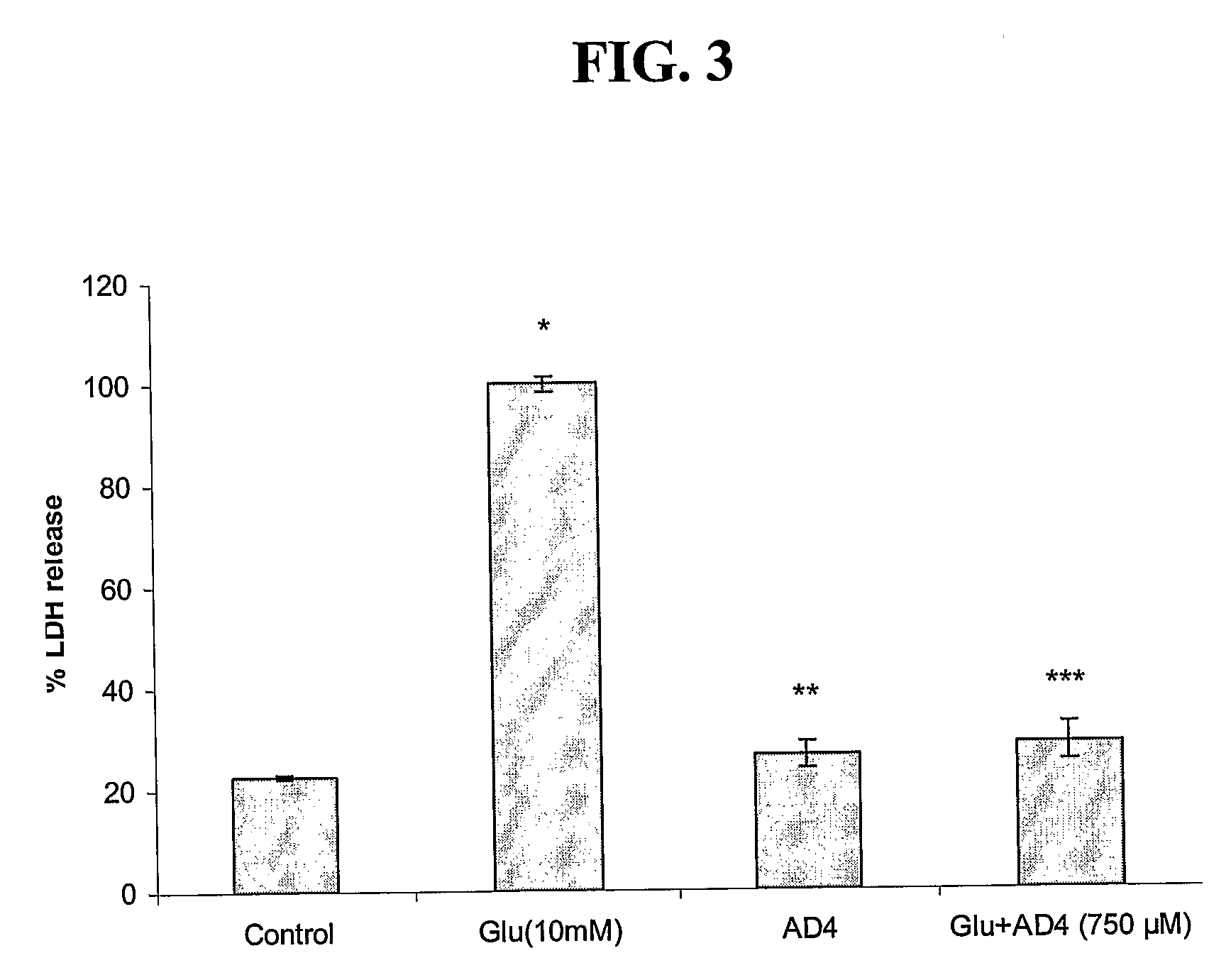N-acetylcysteine amide (nac amide) for the treatment of diseases and conditions associated with oxidative stress
a technology of n-acetylcysteine and n-acetylcysteine, which is applied in the field of n-acetylcysteine amide (nac amide) for the treatment of diseases and conditions associated with oxidative stress, can solve the problems of reducing the oxidative capacity of hif-1. l
- Summary
- Abstract
- Description
- Claims
- Application Information
AI Technical Summary
Benefits of technology
Problems solved by technology
Method used
Image
Examples
example 1
[0195]In this Example, NAC amide was assessed for its protective effects against oxidative toxicity induced by glutamate in PC12 cells.
[0196]Materials and methods: N-(1-pyrenyl)-maleimide (NPM) was purchased from Aldrich (Milwaukee, Wis., USA). N-acetylcysteine amide was obtained from Novia Pharmaceuticals, (Israel). High-performance liquid chromatography (HPLC)-grade solvents were purchased from Fisher Scientific (Fair Lawn, N.J.). All other chemicals were purchased from Sigma (St. Louis, Mo., USA).
[0197]Cell culture and toxicity studies: Stock culture of PC12 cells, purchased from ATCC, were grown in 75 cm2 tissue culture flasks in RPMI 1640, supplemented with 10% (v / v) heat-inactivated horse serum, and 5% (v / v) fetal bovine serum, to which 1% (v / v) penicillin and streptomycin were added. Cultures were maintained at 37° C. in a humidified atmosphere containing 5% CO2. The cells were passaged twice a week. Unless specified, all of the experiments were performed using Dulbecco's mod...
example 2
[0212]This Example examines the radioprotective effects of NAC amide. To evaluate the protective effects of NAC amide against radiation exposure, the radioprotective role of NAC amide was compared with that of NAC with respect to increasing the levels of GSH and returning oxidative stress parameters to their control values.
[0213]Animal studies: The irradiation of rats was performed at the Radiation Oncology Department of the Phelps County Regional Medical Center in Rolla, Mo., using a 16 MeV beam generated by a Varian linear accelerator, model Clinac 1800, and in accordance with the standards of humane laboratory animal protocols. A 20×20 or 25×25 cm field was used and output factors were checked once a week. Twelve animals were divided into 4 groups each containing 3 animals (Control, XRT, NAC amide+XRT and NAC+XRT). The radiation (XRT) control received whole body irradiation by 6 Gy of 16 MeV electrons. The NAC amide+XRT group received 500 mg / kg / day NAC amide immediately before ir...
example 3
[0238]This Example describes a treatment regimen suitable for humans. NAC amide is administered between 1 and three grams per day, in two divided doses, between meals (on an empty stomach). Encapsulated NAC amide (a formulation of NAC amide comprising 500 mg NAC amide and optionally, 250 mg USP grade crystalline ascorbic acid, and not more than 0.9 mg magnesium stearate, NF grade in an OO-type gelatin capsule) is suitable for administration. The administration of exogenous NAC amide is expected to provide a dose response effect in patients, despite the production of large quantities of glutathione in the human body.
PUM
| Property | Measurement | Unit |
|---|---|---|
| Dimensionless property | aaaaa | aaaaa |
| Volume | aaaaa | aaaaa |
| Volume | aaaaa | aaaaa |
Abstract
Description
Claims
Application Information
 Login to View More
Login to View More - R&D
- Intellectual Property
- Life Sciences
- Materials
- Tech Scout
- Unparalleled Data Quality
- Higher Quality Content
- 60% Fewer Hallucinations
Browse by: Latest US Patents, China's latest patents, Technical Efficacy Thesaurus, Application Domain, Technology Topic, Popular Technical Reports.
© 2025 PatSnap. All rights reserved.Legal|Privacy policy|Modern Slavery Act Transparency Statement|Sitemap|About US| Contact US: help@patsnap.com



